
The Amblyopsidae are a fish family commonly referred to as cavefish, blindfish, or swampfish. They are small freshwater fish found in the dark environments of caves, springs and swamps in the eastern half of the United States. Like other troglobites, most amblyopsids exhibit adaptations to these dark environments, including the lack of functional eyes and the absence of pigmentation. More than 200 species of cavefishes are known, but only six of these are in the family Amblyopsidae. One of these, Forbesichthys agassizii, spends time both underground and aboveground. A seventh species in this family, Chologaster cornuta, is not a cave-dweller but lives in aboveground swamps.

The Kentucky cave shrimp is an eyeless, troglobite shrimp. It lives in caves in Barren County, Edmonson County, Hart County and Warren County, Kentucky. The shrimp's shell has no pigment; the species is nearly transparent and closely resembles its nearest relative, the Alabama cave shrimp.

The watercress darter is a species of freshwater ray-finned fish, a darter from the subfamily Etheostomatinae, part of the family Percidae, which also contains the perches, ruffes and pikeperches. It is endemic to the eastern United States where it is only known from the Black Warrior River drainage basin near Birmingham, Alabama.
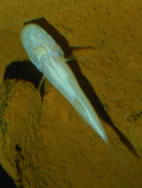
The Alabama cavefish is a critically endangered species of amblyopsid cavefish found only in underground pools in Key Cave, located in northwestern Alabama, United States in the Key Cave National Wildlife Refuge. It was discovered underneath a colony of gray bats in 1967 by researchers Robert A. Kuehne and John E. Cooper and scientifically described in 1974.
The narrow sawfish, also known as the pointed sawfish or knifetooth sawfish, is a species of sawfish in the family Pristidae, part of the Batoidea, a superorder of cartilaginous fish that include the rays and skates. Sawfish display a circumglobal distribution in warm marine and freshwater habitats. Their extant biodiversity is limited to five species belonging to two genera. The sawfishes are characterised by the long, narrow, flattened rostrum or extension on their snout. This is lined with sharp transverse teeth, arranged in a way that resembles the teeth of a saw and are used for killing prey. It is found in the shallow coastal waters and estuaries of the Indo-West Pacific, ranging from the Persian Gulf to southern Japan, Papua New Guinea and northern Australia. It is the only living member of the genus Anoxypristis, but was previously included in the genus Pristis. Compared to Pristis, Anoxypristis has a narrower rostral saw with numerous teeth on the distal part and no teeth on the basal one-quarter. It reaches a length of up to 3.5 m (11 ft).
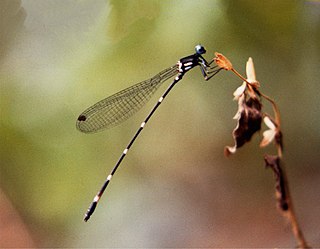
Threatened arthropods are defined here as any of a number of species within the phylum Arthropoda, whose extinction is likely in the foreseeable future. Estimating the number of threatened arthropod species is extremely difficult, primarily because a vast number of the species themselves are not yet named or described. Furthermore, according to Deyrup and Eisner, "The rate of destruction and degradation of natural habitats is currently so great that there are not nearly enough biologists to even catalog the arthropod species that are suddenly on the edge of extinction." In any case, independent estimates indicate that there are millions of undocumented arthropods on Earth.
Spelaeorchestia koloana, the Kauaʻi cave amphipod or ʻuku noho ana in Hawaiian, is a cave-dwelling crustacean only found on the Hawaiian island of Kauaʻi. It is eyeless and measures 7–10 mm (0.28–0.39 in) long. It is only known from 10 populations, and eats decaying plant matter and other decomposing material.

The oldfield mouse, oldfield deermouse or beach mouse is a nocturnal species of rodent in the family Cricetidae that primarily eats seeds. It lives in holes throughout the Southeastern United States in beaches and sandy fields. Predators to these mice include birds and mammals. In 2016, these mice were in the least concern category on the IUCN Red List with certain subspecies classified as extinct, critically endangered, endangered or near threatened.
The Cahaba shiner is a rare species of cyprinid fish. It is endemic to Alabama in the United States, where it is limited to the Cahaba River. It is a federally listed endangered species of the United States.
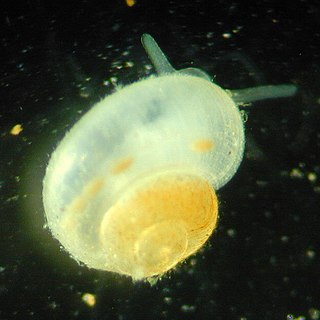
The Tumbling Creek cavesnail is a species of freshwater cave snail with gills and an operculum, an aquatic gastropod mollusk in the family Amnicolidae.
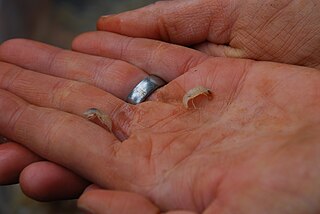
The Madison Cave isopod, Antrolana lira, is a freshwater, cave-dwelling crustacean species. It is in the family Cirolanidae and it is the only species of its genus Antrolana. This isopod can be found in flooded limestone caves and karst aquifers throughout the Great Appalachian Valley of Virginia and West Virginia. The Madison Cave isopod has been listed as a vulnerable species on the IUCN Red List since 1983 and as a threatened species under the United States Endangered Species Act since 1982. The species was named after the cave in which it was first discovered, Madison Saltpetre Cave. Very little is known about the life history and behavior of the Madison Cave isopod.
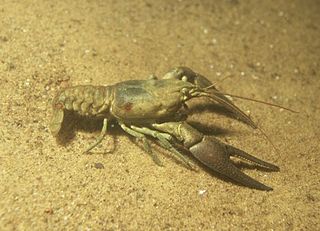
Cambarus aculabrum is a rare species of cave-dwelling crayfish known by the common name Benton county cave crayfish. It is native to Arkansas in the United States, where it is known from only four locations. It is a federally listed endangered species of the United States.

Lirceus is a genus of isopod crustaceans in the family Asellidae that live in southern Canada and the eastern United States as far west as the Great Plains. Of the 15 species in the genus, two are listed as either endangered (EN) or vulnerable (VU) on the IUCN Red List.
Palaemon antrorum, also known as the Balcones cave shrimp and the Texas cave shrimp, is a species of palaemonid shrimp endemic to Texas. It is listed as an endangered species on the IUCN Red List, and as a Species of Concern by the United States Endangered Species Act.

Palaemon cummingi, known as the Squirrel Chimney Cave shrimp or the Florida cave shrimp, is a threatened species of cave-dwelling shrimp in the family Palaemonidae. P. cummingi has been observed in one sinkhole called Squirrel Chimney in Alachua County, Florida near Gainesville. Although exact numbers are unknown, it is speculated that the current P. cummingi population is very small.

Streptocephalus woottoni, with the common name Riverside fairy shrimp, is a rare species of crustacean in the family Streptocephalidae. It is native to Southern California in the United States, and northern Baja California in northwest Mexico.

The genus Palaemonias comprises two species of endangered, albinistic, obligate cave shrimp:

The Alabama shad is an anadromous species of alosid fish endemic to the United States where it breeds in medium to large flowing rivers from the Mississippi River drainage to the Suwannee River, Florida, as well as some other Gulf coast drainages. The biology of this fish is little known but it has become increasingly rare. The International Union for Conservation of Nature rated it "near threatened" in 2020 and the United States National Marine Fisheries Service has listed it as a Species of Concern. A principal reason for its decline is thought to be the many locks and dams blocking access for the fish to up-river spawning grounds.

The spring pygmy sunfish, Elassoma alabamae, is a species of pygmy sunfish endemic to springs in northern Alabama. It was historically known to occur in springs in North Alabama along the Tennessee River in Limestone and Lauderdale counties. The spring pygmy sunfish was first discovered in Cave Spring in Lauderdale County, Alabama in 1937 but in 1938, this site was flooded by the creation of the Pickwick Reservoir. The spring pygmy sunfish was considered extinct until its rediscovery in the Beaverdam Spring complex in 1973 by researchers from the University of Tennessee.















